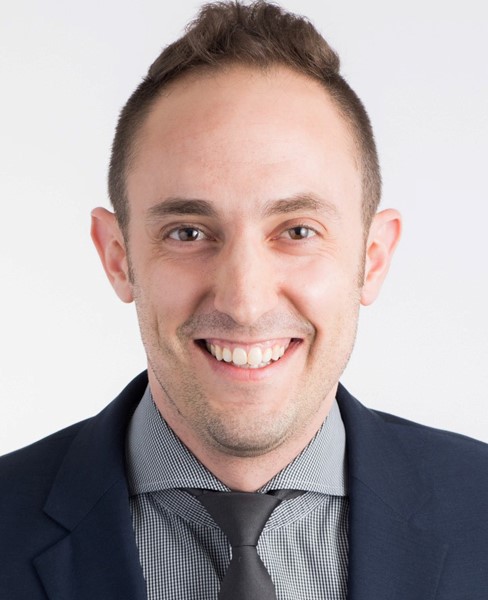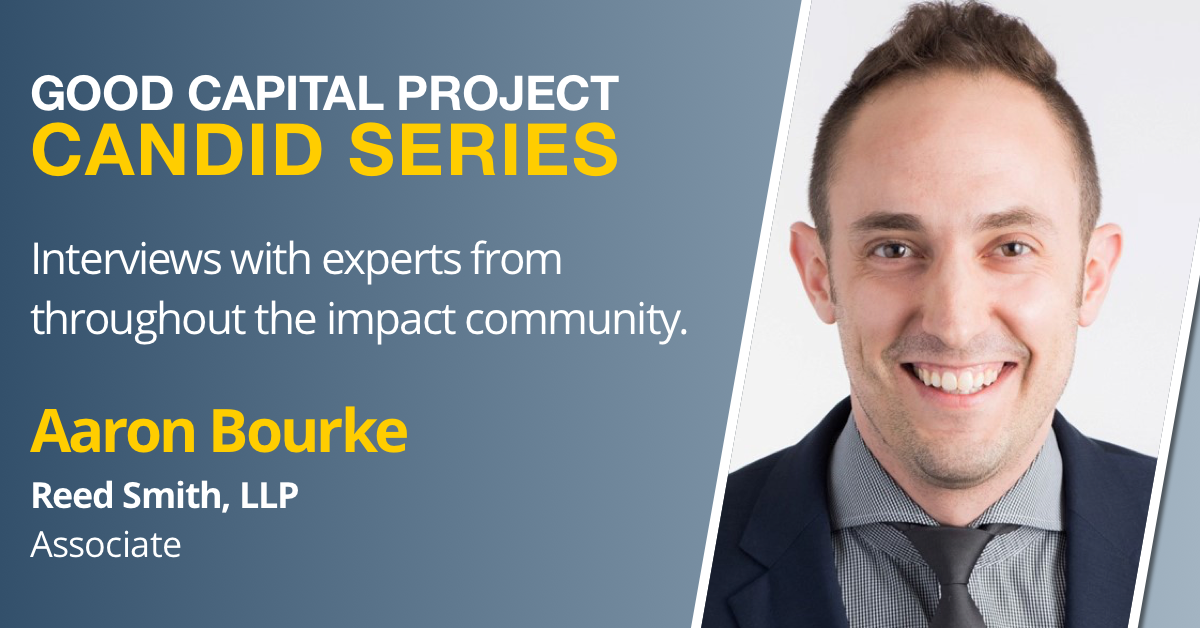
Aaron Bourke is an Associate with Reed Smith Global Corporate Group. He is a founding member of the Reed Smith Social Impact Finance Group and the Impact Investing Legal Working Group.
Good Capital Project: How did the Impact Investing Legal Working Group start? What are your objectives? What are some of the gaps that the group is working to solve?
Aaron Bourke: The Impact Investing Legal Working Group (IILWG) started with humble aspirations and very modest means. The IILWG began with a series of conference calls among lawyers active in impact investing and social entrepreneurship who were keen to build a legal community of practice in this space. From my perspective, I was working at Reed Smith trying to figure out how to build a law practice around social enterprises and impact investing.
Together with other attorneys working in the impact investing sector like Kevin Saunders, now GC of ACCION International; Jim Mercadante, a partner at Reed Smith; Aaron Lewis, Associate GC of Habitat for Humanity International; Lynn Roland, GC of Acumen Fund; Carl Valenstein, now a partner at Morgan Lewis; Mary Rose Brusewitz, now a partner at Clark Hill; and Deborah Burand, now a professor at NYU Law, to name just a few of the IILWG’s original founders, we organically developed monthly calls to discuss how legal professionals can better support social entrepreneurs and impact investors. We wanted to create an open dialogue to help each other identify issues and “work smarter” in this space. From the beginning, we identified “community building” as a core pillar of our working group.
Very quickly, we grew to a fairly large distribution list of people. More people started to ask how they could become involved in the IILWG. At the same time, we realized that there were limits to what a virtual and wholly volunteer community might do, so we decided to begin hosting events where lawyers might gather and share their experiences and learnings as part of a legal community of practice.
Our first physical convening took place four years ago in New York City (fall of 2014) and was attended by around 70 lawyers. That was followed in the spring of 2015 by a conference held in Washington, DC with over 100 attendees. Then, my firm, Reed Smith, hosted our conference in the spring of 2016, which attracted 140 attendees. This past June we held our 5th convening, which was attended by over 320 attorneys from the US and beyond. Now, given the conference’s exponential growth in attendance, our annual conference is held at NYU Law each spring in collaboration with NYU Law’s Grunin Center for Law and Social Entrepreneurship, which has generously assumed the administrative and logistical expenses of running this conference. As part of this collaboration, the IILWG develops the main conference themes and helps to identify and organize speakers for the panels, plenaries, table talk lunches, and workshops. There is so much latent enthusiasm among legal professionals for building law practices with social impact and that is why IILWG continues to grow.
GCP: There is a cultural and generational interest in people aligning their professional careers with social goals. How can aspiring new lawyers help achieve impact through the legal system? How can a lawyer help aggregate capital to grow the industry, advance causes, and structure deals differently?
AB: For any industry to grow, eventually lawyers need to be involved to create the legal framework and structures that allow an efficient market to flourish. There needs to be a rule of law, set of market norms, and legislated regulatory framework which is necessary for an industry to achieve scale. Otherwise, the sector will become the Wild West.
One concrete example I can point to is pay-for-success, social impact bonds. For the space to grow, there had to be involvement from lawyers to figure out the necessary contracts, the parties to the contracts, and what the structures needed to look like. Pay-for-success financing is a pretty revolutionary financial structure where the amount of the financial return is directly tied to the amount of social impact, which isn’t always the case in impact investing. Sometimes, impact investing consists of a deal in which social impact reporting is added on top, but it’s not as though the financial return is constrained by the amount of impact achieved.
The Nonprofit Finance Fund has established a database of pay for success contracts underpinning the social impact bonds being launched in the United States. Prof. Deborah Burand is conducting research scouring this database and reading contracts to identify norms and commonalities across agreements to figure out what’s going on in these deals. Through her research, she’s been able to identify recurrent terms and new trends in how these deals are structured and documented in the U.S. market. This is an example of how the legal profession coalescing around a market norm can help the pay-for-success industry scale up, be more efficient and, eventually, become standardized. The biggest challenge right now is the prohibitively high transaction cost. More standardization and centralized knowledge aggregation can contribute significantly to lowering cost.
Blended finance transactions are another interesting example of a legal structuring concept helping to drive more capital towards impact investing and social enterprises. For instance, deal structures that allow different layers of equity and debt capital so that philanthropic or concessionary capital can crowd-in more market-rate capital.
You could also look at new forms of legal entities, such as Benefit Corporations. Some argue that new legal forms are unnecessary to achieving social impact through business. However, I believe these new forms have the potential to drive more capital towards social ventures both because of the legal frameworks they create and because of their marketing/branding power.
GCP: What were some of the key takeaways from the annual event, Legal Issues In Social Entrepreneurship and Impact Investing – in the U.S. and beyond?
AB: The breadth and vibrancy of the community grows substantially each year. Also, the degree of sophistication from people working in the sector is astounding. By design, our convening is not a beginner-level/training event. We assume attendees have a certain level of fluency in social impact investing, which allows panel conversations to be sophisticated and advanced.
There is a desire amongst members to self-identify as lawyers working in the impact space. This year we had a workshop about branding yourself as an impact investing lawyer and communicating your passion for impact investing to your clients. It was interesting to see lawyers thinking intentionally about how to brand themselves and their practices around impact investing, which indicates this field is gaining mainstream status. Impact investing is no longer something lawyers pursue as a feel-good exercise.
GCP: There is a market validation component – if there is value in branding yourself with a specific market, then there is value to that market.
AB: Exactly. This year people came up with ideas for panel topics that didn’t fit into any of our standard conference themes, so we designed the People’s Choice Track. I attended a People’s Choice panel discussing faith-based impact investing, which was really interesting because this year’s panel was more diverse than the previous year. Some other People’s Choice topics were governing impact funds, sustaining impact practices within law firms, and developing community-driven investment strategies.
GCP: It seems like Reed Smith is very well represented throughout the program. How did Reed Smith’s Social Impact Finance Group come about?
AB: The Social Impact Finance Group was founded by Ranajoy Basu, a partner in Reed Smith’s London office. He specializes in structured finance and is an expert on social impact bonds. I became involved in impact investing because I wanted to blend my big-law training with my prior international development and human rights work in India. I wanted to figure out a way to use my skill set as a deal lawyer to address social and environmental challenges. When Ranajoy announced he was starting the Social Impact Finance Group, I volunteered to help lead the effort in the U.S. I was already working at that point with Jim Mercadante, a partner in our New York office and the head of our U.S. fund formation team. Jim and I, along with others in our New York office, have built the social impact funds component of our Social Impact Finance Group.
The group is evolving into a sustainable practice by developing a business model designed to be financially viable for the firm and our clients. Due to our firm’s expertise in social impact funds and social impact bonds, we have been able to attract work that showcases the ability for impact investing to be a viable business opportunity for law firms.
GCP: Do you see a sustained interest in this field from new, incoming lawyers?
AB: Through IILWG, I have met a lot of lawyers who are committed to working in impact investing. Based on the growing interest in this space, I believe the Social Impact Finance Group within Reed Smith is a unique recruiting opportunity to differentiate ourselves from other firms. There is a ton of enthusiasm from young attorneys wanting to be involved in this space. Young lawyers want to strike a balance between achieving social impact and professional success from the very beginning of their careers.




